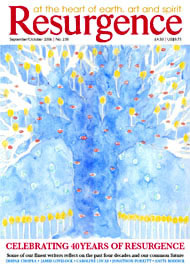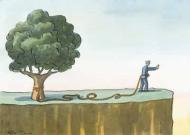IF ONE SEEKS revelatory moments to explain sharp turns in life, then this was one for me. It was in 1964, during one of many Martini-drinking evenings with David Brower, the late inspirational leader of the Sierra Club. Between drinks we discussed an advertising series he had asked me to help write and design, opposing new mega-dams being planned for the Grand Canyon.
I was in the commercial advertising business at that time. I was excited to be able to speak imagery into the brains of millions of people and see them react as we wanted. Of course, in passing, I was also seeing how these fabulous new technologies of mental invasion were slowly bringing a global homogenisation of commodity consciousness. But I did not yet see much of a problem with that.
Brower's assignment was difficult. Las Vegas interests had been pushing for big dams to provide electricity to expand into the south-western desert. Congress was poised to authorise them. Desperate measures were required, Brower said. These dams would submerge hundreds of miles of wilderness river gorges, leaving lakes as much as a mile deep. The strata of those magnificent canyon walls, formed over billions of years, displayed the geologic history of the world. Equally important, Brower said, was that the experience of being in those canyons put people in touch with creation, and projected their consciousness back to the roots of existence. Drowning the canyons for corporate profits, during a brief one-century blip of geologic time since the industrial revolution, he said, would be an outrage to nature, to human consciousness, and to God.
The developers of the dams said the lakes would be a great thing, since they would encourage tourists in power-boats to get higher up the canyon walls for a closer look. So, the first ad of the series was headlined "Should We Flood the Sistine Chapel So Tourists Can Get Nearer the Ceiling?"
That ad, and several that followed, produced tens of thousands of written letters (pre-internet) to Congress. The dams were halted. Stewart Udall, then Secretary of the Interior under President Johnson, praised the ad campaign, calling it the first projection of a new modern environmental movement.
The ad series also projected me right out of the commercial advertising business. Immersing myself in the environmental message of the 1960s, I finally understood that using the most powerful mentally invasive instruments on Earth to trivialise and commodify existence was not such an ideal calling. I closed the commercial ad agency and started a new non-profit company that worked only for environmental, social and anti-war causes. It still exists today in San Francisco - the Public Media Center.
THEN, IN THE early 1970s, the first statistics on the advance of global television viewing were published. The average person in industrial countries was already watching about four hours of TV per day, and in some countries - notably the US - seeing more than 23,000 commercials per year. People were spending more time watching television than doing anything else in life besides sleeping, working or going to school. For a majority of people, television viewing was the main activity of their day: passively ingesting powerful imagery projected by a small number of commercial interests with intent. Electronic media were replacing direct experience of a wider world, substituting secondary and tertiary processed knowledge and experience; mediated reality; virtual reality. The Orwellian vision of mind control was near realisation.
What was true for industrial countries in the 1970s was soon true everywhere - people in grass houses in Borneo or in northern tundras were staring at satellite images of Dallas or Baywatch. Global mass media were morphing diverse cultural consciousnesses into clones of the commodity culture that dominated imagery, knowledge and experience. We see the outcomes nearly everywhere, today.
That was the point when I decided to write Four Arguments for the Elimination of Television, to amplify the invasive, controlling, stupefying, globally homogenising impacts of television, now in the hands of ever fewer global corporate giants.
At first, I never thought of Four Arguments as an anti-globalisation book. But now I do: the first of three books that are reiterations of similar warnings, via different prisms. The next book, In the Absence of the Sacred, covered two other related points: first, the role of other modern technologies in alienating human experience, while ravaging the Earth; and second, the unique rapidly growing role of the world's remaining 300 million indigenous people in resisting that process.
INDIGENOUS KNOWLEDGE AND cultural, economic and spiritual practices are expressions of non-mediated societies rooted in direct contact with nature, operating from values nearly opposite to our own. They offer an antidote to the modern dilemma. It is no small irony, however, that the very success of indigenous peoples of the world in sustaining viable traditional societies over millennia, without destroying their lands or biodiversity - wildlife, forests, waters, biota - has also made them prime targets for modern resource-addicted global corporations who seek to invade and exploit those lands. Organised indigenous resistance to these advances is now expanding on every continent, most spectacularly in South America in such places as Bolivia, Ecuador and Peru. These movements must be supported by non-indigenous activists everywhere.
In the Absence of the Sacred was published in 1991. In that same year, I began conversations that were arguably as significant for me as those with Brower, this time with Doug Tompkins, a friend of thirty years who had founded the clothing company ESPRIT. Tompkins told me he was quitting business, and asked me to help launch his new Foundation for Deep Ecology.
One of the first activities we agreed to work on was the grave threat of economic globalisation. If mass media represented the internal mental homogenisation process, then economic globalisation - the new global structures that transfer real power away from local communities and nation-states to global corporate institutions - represents the external unification, centralisation and homogenisation process; the remaking of economic and political forms to better fit narrow corporate purposes, with horrendous implications for nature. In 1993, we convened a meeting of leading thinkers and activists who were already at work on this problem - notably Edward Goldsmith, Vandana Shiva, Maude Barlow, Helena Norberg-Hodge, Martin Khor, Tony Clarke, Dave Korten, Walden Bello and Lori Wallach, among others. That, in turn, soon led to the formation of the International Forum on Globalization (IFG), and ramped up efforts to stimulate, through public teach-ins, publications and activism, an effective global opposition movement, which later burst onto the scene in Seattle. It also led me to partner with Edward Goldsmith for the third leg of the trilogy, The Case Against the Global Economy, and For a Turn Toward the Local.
OF COURSE ALL of this work continues today, with the increased focus of many groups on actualising viable alternative, local, ecological economics. And IFG has a new book, Paradigm Wars: Indigenous Peoples' Resistance to Economic Globalization, which surveys and supports that movement. To say that it all began with martinis with David Brower in New York may be stretching the point, but in my own life it certainly created the initial earthquake of consciousness that pushed me down many pathways to here. o








